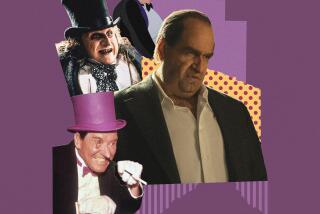With ‘Justice League,’ Superman is back in movies. But he’s always been better on TV
Who is Superman, what is he, that all his fans commend him? The character is not without precedent — you can find him foreshadowed in Paul Bunyan, John Henry, the Scarlet Pimpernel, the Phantom. But he was the complete package — the powers, the costume, the cape, the alter ego — successful from his first appearance (Action Comics, June 1938) and the inspiration for legions and leagues of superheroes to follow. Although he has not always been No. 1 on the hit parade — notably eclipsed by Batman, the Lennon to his McCartney, the Fonzie to his Richie — he is ever with us, the Original All-American Alien Orphan Boy, with powers far beyond those of mortal men but also a regular Joe with a job who has to pay rent.
He’s having a moment now, the big lug, on multiple fronts. March 18 sees “Zack Snyder’s Justice League” debuting on HBO Max. There is talk that Michael B. Jordan, or someone, will play a Black Superman in a new film to be written by journalist and sometime comics author Ta-Nehisi Coates, leading fans of Henry Cavill, the most recent big-screen Superman, to wonder what that means for their Man of Steel. In quite another key, London’s Times Literary Supplement has published “The Man of Tomorrow’s Lament,” a lost poem by Vladimir Nabokov, from 1942, in which Superman muses upon the inadvisability of his love for (and sex and children with) Lois Lane. And the CW has cut the ribbon on the very appealing “Superman & Lois,” the newest wing on the Greg Berlanti-overseen “Arrowverse” and the fifth live-action television series to feature the character, if you count, or even remember, “Superboy,” syndicated from 1988 to 1992 (after a failed pilot in 1961).
Superman is naturally at home in the comics, and the movies generate the most money and buzz — Richard Donner’s lighthearted 1978 “Superman” put the character back on the national stage and made a star of Christopher Reeve, who played him three more times.
But the character has perhaps been most interesting on television. Superhero movies are big and expensive and don’t come along every day — it’s part of what makes them movies — while a single season of a CW series is as long as half a dozen Zack Snyder director’s cuts. Budgets being what they are, TV shows depend more on talking than action, which deepens character even when nothing crucial is being said; films may suggest relationships, but series embody them, over weeks and years, in actual people: ABC’s “Lois and Clark: The New Adventures of Superman,” with Teri Hatcher and Dean Cain in the title roles, which premiered in 1993, the year of “Sleepless in Seattle,” was three parts romantic comedy to one part sci-fi. (It took some cues from the Reeves films.) “Superman and Lois” is a relatively naturalistic family drama, set in Smallville, with the saga’s central couple the parents of teenagers.
In Marvel’s “WandaVision,” nothing is as it seems. So we prepared an episode-by-episode guide to the Disney+ series for you to keep handy as you watch.
Television has room to wander a little, to mix in moments of behavior and banter. Even a show with as little character development as the non-serial “The Adventures of Superman,” which first brought the character to television in 1952 and ran for six seasons, acquired a patina of reality, a goofball gravitas, just by showing up week after week. George Reeves’ Superman, Noel Neill‘s Lois Lane (replacing Phyllis Coates in year two), Jack Larson’s Jimmy Olsen and John Hamilton’s Perry White make a family — you feel this even from a few episodes. Like “Seinfeld,” if Kramer came in through the wall and Jerry left jumping through the window.
What makes Superman special is his clarity, the unambiguous, selfless goodness that defines his character and survives every side trip into darker shades. As the most powerful person on Earth next to Oprah, he could rule this roost; but he has been raised right. In early comics, he’s styled “a champion of the helpless and oppressed” — that “American Way” line came later, on TV, in the pious patriotism of the 1950s — who fights not only crooks and con men, but also a lynch mob, reckless drivers, war profiteers, the sadistic boss of a chain gang and slipshod contractors. (One misses these simple acts of civic duty. Nowadays it’s all supes vs. supes.) Because he is strong from within as well as without — his moral core as solid as his impervious frame — any hint of vulnerability is disturbing: the loss of strength, the loss of self. We who are only human can relate.
Identity is an overarching theme in “Superman.” The face you show the world, the one that looks like you to you. Clark, a foundling, born Kal-El, famous as Superman, has lost his memory more than once and regularly comes face to face with, and sometimes fist to fist with, perverse reflections or imitations of himself. He will lose his powers and recover them; die and be reborn, with the ineradicable resilience of valuable intellectual property, always much the same, never exactly the same. Change is inevitable in a story told over decades, every succeeding vehicle forged in a crucible of corporate synergy, fan service, new fashions, creative inspiration and the desire to stay in business.
“The Boys” is back for Season 2 on Amazon Prime Video. And whether you’re a super-skeptic or a Marvel fanatic, its blistering cultural satire is for you.
It is expected in the ongoing age of Marvel and 35 years after Frank Miller turned Batman into the Dark Knight, that superheroes have issues. But in his early days — in the comics, on the radio and in the original TV series — Superman didn’t worry much about who he was; he just got on with the job. (His back story occupies only a few panels in his first comic book appearance.) But as the Nabokov poem demonstrates, other people might have been wondering for him: “And when she sighs — somewhere in Central Park/where my immense bronze statue looms — ‘Oh, Clark …/Isn’t he wonderful!?!’ I stare ahead/and long to be a normal guy instead.” It’s a sort of reboot before its time.
Along the way, there have been much tinkering and retconning and decades of accrued detail and storylines that may have contradicted earlier storylines. Indeed, there were so many of these variations among DC superheroes, accommodated by the creation of multiple Earths, that in 1985 DC Comics launched “Crisis on Infinite Earths” to compress many worlds into one. At the end of 2019, the Arrowverse borrowed the title and concept for a crossover event spread across five series, including a belated epilogue to “Smallville” — which ran a healthy 10 seasons on the WB and successor the CW beginning in 2001 — in which Clark and Lois, played by Tom Welling and Erica Durance, are living on the old homestead with daughters, Clark having mystically surrendered his powers to lead a normal life. (Are you listening, Vladimir Nabokov?) Like any housecleaning, it clears the way for things to get messy again.
On television especially, Clark Kent is as important as Superman. (“Superman is what I can do, Clark is who I am,” Cain’s Clark tells Hatcher’s Lois in “Lois and Clark.”) Oddly, it’s his very ordinariness that makes the character special, and useful in so many modes and mediums and genres — a low-budget kids show, a romance, a high school soap, a family drama. (There have been cartoons as well.) In every case, Clark Kent is as attractive a character when he’s got the glasses on as when they’re off, which is most of the time — witty, capable, broad-shouldered, a leader. Bruce Wayne, by comparison, is only really interesting when he’s Batman.
With the classic “The Muppet Show” now streaming on Disney+, Times TV critic Robert Lloyd explains the meaning and majesty of Jim Henson’s iconic creations.
True to its name, “Smallville” was an ensemble drama, in which Clark was merely the hub of a story with many spokes. It practiced a “no flights, no tights” policy, taking its time to reveal to teenage Clark his true self and various powers; and indeed, the character never flew, wore the costume or called himself Superman until the series’ end. (Welling’s red James Dean jacket was a sort of uniform.) Like various Arrowverse series to come, it had, beneath the paranormal brouhaha, the complicated heart of a soap opera. Like “Buffy the Vampire Slayer,” it began as a high school story, fitted with monsters and metaphors, and survived long enough to see the characters out in the wider world — long enough for a class reunion episode and Clark to get together with Lois.
“Superman & Lois” is kind of a half-reboot of “Smallville” with a touch of “Lois & Clark,” as the Kent-Lanes move back to Clark’s hometown to spend “more time with each other and be part of a community,” albeit one suffering from economic insecurity, meth, media mistrust and “sadness.” Leads Tyler Hoechlin and Elizabeth Tulloch, who played their characters on the CW’s “Supergirl,” have lived-in chemistry — they feel genuinely coupled and parental, for better and worse.
As in “Smallville,” Clark is only part of the story. “You know what, babe, you do your Superman stuff and I will do my Lois Lane stuff,” says Lois, who already has her notebook out, sniffing something fishy as regards billionaire Morgan Edge (Adam Rayner), a sort of Elon Musk/Jeff Bezos character bringing his business to town. (“He busts up unions, he barely pays a living wage,” she notes.) It revives the high school setting for twin sons Jonathan (Jordan Elsass), to whom things come easy, and Jordan (Alexander Garfin), to whom they come hard. “The boys need to see what a strong and loving and vulnerable man looks like, what your father was to you,” says Ma Kent, before departing whatever number world this is set in 15 minutes into the premiere. Things get no easier when they learn how dad has been moonlighting all those years and how that fact might improve or ruin their lives: “How come he gets to go flying with Dad and I have to go to school?”
“Am I a bad father?” wonders Clark, who has often been away saving people to whom he is not related. Is this his greatest challenge yet? It may not be a job for Superman. Stay tuned.
‘Superman & Lois’
Where: The CW
When: 9 p.m. Tuesday
Rating: TV-PG-LV (may be unsuitable for young children with advisories for coarse language and violence)
More to Read
The complete guide to home viewing
Get Screen Gab for everything about the TV shows and streaming movies everyone’s talking about.
You may occasionally receive promotional content from the Los Angeles Times.








